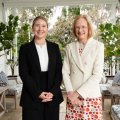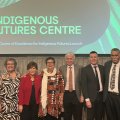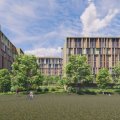UQ researchers lead international effort to conserve Malaysian turtles
University of Queensland researchers are leading an international effort to save Malaysia's Green Turtle population.
In July this year, 25 volunteers from around the world including Australians, Indonesians, Americans, Britons and Singaporeans joined a University Anatomical Sciences Department team monitoring turtle hatchlings from three Malaysian Government-run hatcheries on the country's east coast. Led by Department senior lecturer Joan Whittier, the three-year research project is funded by a $109,000 Earthwatch Institute grant.
The Boston-based Institute provides funds, direction and volunteers to environmental problem-solving projects throughout the world. In Malaysia each evening, volunteers recorded information about turtles and their hatchlings such as size, markings and nesting locations, tagging the front flippers of some. Others relocated nests to the safety of the hatcheries, recording data on numbers of eggs and assigning them to buried positions of either full sun or shade.
"Recent research by University Adjunct Professor and research scientist Col Limpus has shown problems with the hatcheries including a sex bias towards females. In these turtles, sex is determined by sand temperature and as many hatcheries are not shaded with sand temperatures creeping up to 32 degrees Celsius, almost 100 percent of hatchlings were female," Dr Whittier said.
"A significant part of our research is determining optimum conditions for these hatcheries to ensure a natural ratio of male and female hatchlings."
Dr Whittier said the Malaysian Government's concern for turtle conservation began in 1960 with the establishment of enclosed, staffed hatcheries on the country's beaches. Local people collect eggs and sell them to the hatcheries rather than at markets. Up to 60 percent of eggs produced by female turtles are now purchased by the Malaysian Government and incubated in hatcheries every year.
Accompanying the expedition were three University PhD students, Mark Hamann, Tim Jessop and senior research officer from the Malaysian Fisheries Department Kamarruddin Ibrahim. Kamarruddin said turtle eggs were considered a delicacy in Malaysia and were boiled and eaten to promote virility. This practice had reduced the Green Turtle population in the country by 60 percent in the past 50 years.
He said the recent trip showed encouraging results of conservation measures including an 83 per cent success rate in hatchlings from the Government-run hatcheries compared to an 85-88 percent success rate at naturally occurring hatcheries in Australia.
"The Green Turtle is the second largest turtle in Malaysia reaching lengths of one metre and weights of around 180 kilograms. We think they live to around 100 years and reach sexual maturity at between 30 and 40 years. Each female lays around 100 eggs per nest six times during the nesting season between April and September," he said.
Green Sea Turtles feed in Moreton Bay and nest from Heron Island to the top end of Australia. Mr Hamann's research also concerns the turtle's natural nesting areas on Heron Island. In Malaysia, he and Mr Jessop tested the running and swimming performance of hatchlings as they made their way from their egg shells on the beach to the water.
Dr Whittier said the trip also provided an opportunity to train three Indonesian volunteers on Earthwatch Institute and Rio Tinto Fellowships in the area of turtle conservation.
For more information, contact Dr Joan Whittier (telephone 07 3365 2536).




